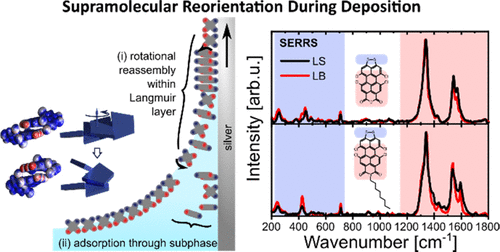Our official English website, www.x-mol.net, welcomes your
feedback! (Note: you will need to create a separate account there.)
Supramolecular Reorientation During Deposition Onto Metal Surfaces of Quasi-Two-Dimensional Langmuir Monolayers Composed of Bifunctional Amphiphilic, Twisted Perylenes
Langmuir ( IF 3.7 ) Pub Date : 2021-09-10 , DOI: 10.1021/acs.langmuir.1c01525 Maximilian L Hupfer 1, 2 , Robert Meyer 1, 2 , Tanja Deckert-Gaudig 1, 2 , Soumik Ghosh 1, 2, 3 , Artem Skabeev 4 , Kalina Peneva 4 , Volker Deckert 1, 2, 5 , Benjamin Dietzek 1, 2 , Martin Presselt 1, 3, 6
Langmuir ( IF 3.7 ) Pub Date : 2021-09-10 , DOI: 10.1021/acs.langmuir.1c01525 Maximilian L Hupfer 1, 2 , Robert Meyer 1, 2 , Tanja Deckert-Gaudig 1, 2 , Soumik Ghosh 1, 2, 3 , Artem Skabeev 4 , Kalina Peneva 4 , Volker Deckert 1, 2, 5 , Benjamin Dietzek 1, 2 , Martin Presselt 1, 3, 6
Affiliation

|
Supramolecular dye structures, which are often ruled by π–π interactions between planar chromophores, crucially determine the optoelectronic properties of layers and interfaces. Here, we present the interfacial assembly of perylene monoanhydride and monoimide that do not feature a planar chromophore but contain chlorine substituents in the bay positions to yield twisted chromophores and hence modified π-stacking. The assembly of the twisted perylene monoanhydride and monoimide is driven by their amphiphilicity that ensures proper Langmuir layer formation. The shielding of the hydrophilic segment upon attaching an alkyl chain to the imide moiety yielded a more rigid Langmuir layer, even though the degrees of freedom were increased due to this modification. For the characterization of the Langmuir layer’s supramolecular structure, the layers were deposited onto glass, silver, and gold substrates via Langmuir–Blodgett (LB) and Langmuir–Schaefer (LS) techniques and were investigated with atomic force microscopy and surface-enhanced resonance Raman spectroscopy (SERRS). From the similarity between all SERR spectra of the LS and LB layers, we concluded that the perylenes have changed their orientation upon LB deposition to bind to the silver surface of the SERRS substrate via sulfur atoms. In the Langmuir layer, the perylenes, which are π-stacked with half of the twisted chromophores, must already be inclined and cannot achieve full parallel alignment because of the twisting-induced steric hindrance. However, upon rotation, the energetically most favorable antiparallel aligned structures can be formed and bind to the SERRS substrate. Thus, we present, to the best of our knowledge, the first fabrication of quasi-two-dimensional films from twisted amphiphilic perylene monoimides and their reassembly during LB deposition. The relation between the molecular structure, supramolecular interfacial assembly, and its adoption during adsorption revealed here is crucial for the fabrication of defined functionalizations of metal surfaces, which is key to the development of organic (opto)electronic devices.
中文翻译:

由双功能两亲、扭曲苝组成的准二维朗缪尔单层在沉积到金属表面期间的超分子重新定向
超分子染料结构通常由平面发色团之间的 π-π 相互作用决定,对层和界面的光电特性至关重要。在这里,我们展示了苝单酐和单酰亚胺的界面组装,它们不具有平面发色团,但在海湾位置包含氯取代基以产生扭曲的发色团,从而改进了 π 堆积。扭曲的苝单酐和单酰亚胺的组装是由它们的两亲性驱动的,可确保适当的朗缪尔层形成。在将烷基链连接到酰亚胺部分时,亲水链段的屏蔽产生了更刚性的朗缪尔层,即使由于这种修改而增加了自由度。为了表征朗缪尔层的超分子结构,通过 Langmuir-Blodgett (LB) 和 Langmuir-Schaefer (LS) 技术将这些层沉积在玻璃、银和金基板上,并用原子力显微镜和表面增强共振拉曼光谱 (SERRS) 进行研究。根据 LS 和 LB 层的所有 SERR 光谱之间的相似性,我们得出结论,苝在 LB 沉积时改变了它们的取向,以通过硫原子结合到 SERRS 基板的银表面。在朗缪尔层中,与一半扭曲发色团 π 堆叠的苝必须已经倾斜并且无法实现完全平行排列,因为扭曲引起的空间位阻。然而,在旋转时,可以形成能量上最有利的反平行排列结构并结合到 SERRS 基底。因此,我们提出,据我们所知,首次从扭曲的两亲苝单酰亚胺制备准二维薄膜,并在 LB 沉积过程中重新组装。这里揭示的分子结构、超分子界面组装及其在吸附过程中的采用之间的关系对于金属表面的定义功能化的制造至关重要,这是有机(光)电子器件发展的关键。
更新日期:2021-09-21
中文翻译:

由双功能两亲、扭曲苝组成的准二维朗缪尔单层在沉积到金属表面期间的超分子重新定向
超分子染料结构通常由平面发色团之间的 π-π 相互作用决定,对层和界面的光电特性至关重要。在这里,我们展示了苝单酐和单酰亚胺的界面组装,它们不具有平面发色团,但在海湾位置包含氯取代基以产生扭曲的发色团,从而改进了 π 堆积。扭曲的苝单酐和单酰亚胺的组装是由它们的两亲性驱动的,可确保适当的朗缪尔层形成。在将烷基链连接到酰亚胺部分时,亲水链段的屏蔽产生了更刚性的朗缪尔层,即使由于这种修改而增加了自由度。为了表征朗缪尔层的超分子结构,通过 Langmuir-Blodgett (LB) 和 Langmuir-Schaefer (LS) 技术将这些层沉积在玻璃、银和金基板上,并用原子力显微镜和表面增强共振拉曼光谱 (SERRS) 进行研究。根据 LS 和 LB 层的所有 SERR 光谱之间的相似性,我们得出结论,苝在 LB 沉积时改变了它们的取向,以通过硫原子结合到 SERRS 基板的银表面。在朗缪尔层中,与一半扭曲发色团 π 堆叠的苝必须已经倾斜并且无法实现完全平行排列,因为扭曲引起的空间位阻。然而,在旋转时,可以形成能量上最有利的反平行排列结构并结合到 SERRS 基底。因此,我们提出,据我们所知,首次从扭曲的两亲苝单酰亚胺制备准二维薄膜,并在 LB 沉积过程中重新组装。这里揭示的分子结构、超分子界面组装及其在吸附过程中的采用之间的关系对于金属表面的定义功能化的制造至关重要,这是有机(光)电子器件发展的关键。










































 京公网安备 11010802027423号
京公网安备 11010802027423号